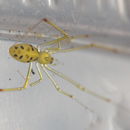Happy face spider (Theridion grallator)
provided by EOL authors
The happy face spider or nananana makakiʻi (face-patterned spider) belongs to the family Theridiidae. The specific name grallator is Latin for "stilt walker", linked to the species' long, spindly legs. The spider is endemic to Oʻahu, Molokaʻi, Maui and the island of Hawaiʻi in rainforests at elevations of 300–2,000 m (980–6,560 ft).
The spider is up to 5 mm (0.20 in) long (1). Some morphs have a pattern resembling a smiley face or a grinning clown face on their yellow body. Each spider has a unique pattern and these differ from island to island. Some lack markings altogether (1,5). On Maui, the happy types seem to follow simple Mendelian inheritance rules; on other islands the body inheritance patterns seem to be sex-limited (2). The variation may provide camouflage against birds to counteract pattern recognition by predators by confusing them (5). Dr Geoff Oxford (5) says that when a bird or other predator sees a prey item for the first time, there is a moment before it decides whether to eat it or not. The spider may have developed these variations to take advantage of this, so it can escape before the predator decides it is food. Oxford doubts if the smiling face is enough to put off a bird. As the pattern may change due to what food the spider eats (3) and as the spider is very small, hides by day and is thus not a significant prey item for any species of predator, the variety of patterns may serve no significant adaptive purpose.
The spider lives beneath the leaves of plants, where it spins its much reduced webs (3). It hunts mainly in the evening. Females guard their eggs until they hatch and catch prey for their young.
The spider is harmless to humans (5). It is under threat from extinction. Dr Oxford (5) said the unusual markings has made ithem an ambassador for Hawaii's threatened wildlife. Conservationists are using them to highlight the plight of native species and the spider's image appears on T-shirts, baseball caps and post cards. The spider's closest relatives include T. posticatum and T. kauaiense from Hawaii. This "T. grallator clade" may be more closely related to the genus Exalbidion than to any other species currently classified in Theridion (4).

